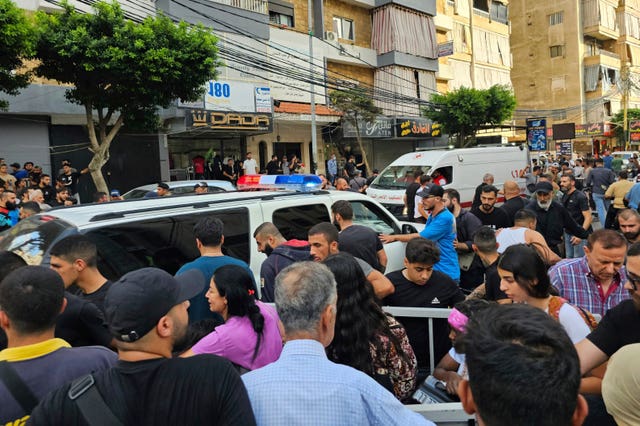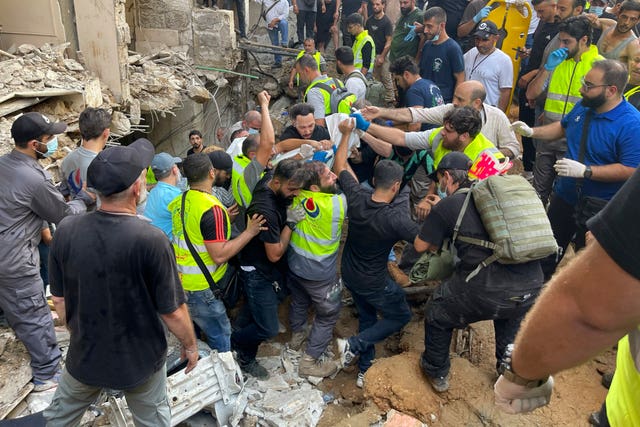At least 14 killed and 60 wounded in Israeli strike on Beirut
The strike in the city’s crowded southern suburbs on Friday reportedly targeted a senior Hezbollah commander.

An Israeli strike on Beirut killed at least eight people and wounded more than around 59 others, Lebanese health officials said.
The strike on Friday is the first Israeli attack on the Lebanese capital in months that came after Hezbollah pounded northern Israel with rockets.
Israel announced the strike, but did not immediately specify the target in Beirut’s crowded southern suburbs, where Lebanon’s Hezbollah militant group holds sway.

Lebanon’s Health Ministry reported that at least 14 people were killed and 60 others wounded as local networks broadcast footage of wounded people being pulled from the ruins of a flattened building and ambulances rushing to the scene of the strike.
The strike in Dahiyeh, just kilometres from downtown Beirut, hit during rush hour, as people were leaving work and students headed home from school.
The escalation came as the region awaited the revenge promised by the militant group’s leader, Hassan Nasrallah, for this week’s mass bombing attack on pagers and walkie-talkies belonging to Hezbollah members.
An Israeli official later confirmed that the Israeli military targeted Ibrahim Akil, a senior Hezbollah military official, in the strike.
It was not immediately clear if Akil was killed.
The Israeli official spoke on condition of anonymity because he was discussing a behind the scenes security matter.
An official close to the Hezbollah militant group, also speaking on condition of anonymity because he was not authorized to brief the media, confirmed to The Associated Press that Akil was supposed to be in the building when it was targeted on Friday.
The official could not confirm if Akil was killed.

Akil has served as the head of Hezbollah’s elite Radwan Force and Jihad Council, the group’s highest military body.
The US State Department has sanctioned Akil for his alleged role in carrying out the 1983 bombing of the US Embassy in Beirut and that he had directed the taking of American and German hostages in Lebanon and held them there during the 1980s.
Israel’s rare strike on the Beirut suburbs came after Hezbollah pounded Israel with 140 rockets, which the Israeli military said came in three waves targeting sites along the ravaged border with Lebanon.
Following the attacks, the Israeli military said that it had struck areas across southern Lebanon targeting Hezbollah infrastructure, but did not provide details of damage.
Hezbollah said that its attacks had targeted several sites along the border with Katyusha rockets, including multiple air defence bases as well as the headquarters of an Israeli armoured brigade they said they had struck for the first time.
The Israeli military said that 120 missiles were launched at areas of the Golan Heights, Safed and the Upper Galilee, some of which were intercepted.
Fire crews were working to extinguish blazes caused by pieces of debris that fell to the ground in several areas, the military said.
The military did not say whether any missiles had hit targets or caused any casualties.

Another 20 missiles were shot at the areas of Meron and Netua, and most fell in open areas, the military said, adding that no injuries were reported.
Hezbollah said that the rockets were in retaliation for Israeli strikes on villages and homes in southern Lebanon, not two days of attacks widely blamed on Israel that set off explosives in thousands of Hezbollah pagers and walkie-talkies.
On Thursday, Israel said its military had struck “hundreds of rocket launcher barrels” in southern Lebanon, saying that they “were ready to be used in the immediate future to fire toward Israeli territory”.
The army also ordered residents in parts of the Golan Heights and northern Israel to avoid public gatherings, minimise movements and stay close to shelters in anticipation of the rocket fire that eventually came on Friday.
Hezbollah and Israel have exchanged near-daily fire since October 8, a day after the Israel-Hamas war’s opening salvo, but Friday’s rocket barrages were heavier than normal.
Nasrallah on Thursday vowed to keep up daily strikes on Israel despite this week’s deadly sabotage of its members’ communication devices, which he described as a “severe blow”.
At least 20 were killed in the attacks and thousands were wounded when pagers, walkie-talkies and other devices exploded in Lebanon on Tuesday and Wednesday.
The sophisticated attacks have heightened fears that the cross-border exchanges of fire will escalate into all-out war.

Israel has neither confirmed nor denied involvement in the attacks.
In recent days, Israel has moved a powerful fighting force up to the northern border, officials have escalated their rhetoric, and the country’s security Cabinet has designated the return of tens of thousands of displaced residents to their homes in northern Israel an official war goal.
Fighting in Gaza has slowed, but casualties continue to rise.
Overnight, Palestinian authorities said that 15 people were killed in multiple Israeli attacks in the Gaza Strip.
Those included six people, including an unknown number of children, in an airstrike early on Friday morning in Gaza City that hit a family home, Gaza’s Civil Defence said.
Another person was killed in Gaza City when a strike hit a group of people on a street.
Israel maintains that it only targets militants, and accuses Hamas and other armed groups of endangering civilians by operating in residential areas.
The military, which rarely comments on individual strikes, had no immediate comment.
Gaza’s Health Ministry says that more than 41,000 Palestinians have been killed in the territory since Hamas’ October 7 attack.
The ministry does not differentiate between fighters and civilians in its count, but says a little over half of those killed were women and children.
Israel says it has killed more than 17,000 militants, without providing evidence.
More than 95,000 people have also been wounded in Gaza since October 7, the Health Ministry said.
The war has caused vast destruction and displaced about 90% of Gaza’s population of 2.3 million.





